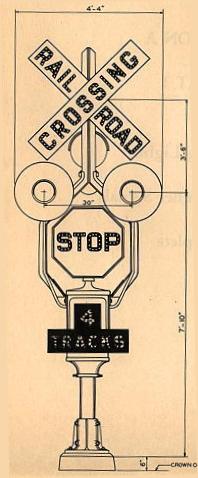Griswold Flashing
light
with rotating banner

Animation by Joe Stachler
|
It
seems that not a whole lot is known about these interesting crossing signals.
They were produced by the Griswold Signal Company of
The signals operated in the following way. When activated by an oncoming train, power would be cut from the hold-clear mechanism which would release and a weight, connected by a chain to the stop sign, would drop with a loud thud. This would rotate the stop sign to face oncoming auto traffic. When the train cleared the crossing, power would be applied to a motor which would lift the weight and the hold-clear mechanism would engage to hold the weight up. Once the hold-clear mechanism had engaged, power to the motor cut off. This rotated the stop sign 90° so that it was not seen by oncoming auto traffic. Most Griswolds originally had overhead lamps to illuminate the crossbuck and stop sign. As time went by, many of the signal received some slight modifications. In many cases, crossbucks were replaced with more modern sheet metal blades and the lamps that lit the crossbucks and stop signs were phased out. Original crossbucks were either reflectorized or were the narrow width type, as seen above. Also, stop signs were replaced as the old ones became abused and rusted. Original stop signs on these were usually Federal Yellow and in some cases, reflectorized. These early signals used a unique egg-shaped light housing that was mounted from the bottom of the light fixture. Later Griswolds were manufactured with the standard "Type B" lights that were used in their crossing signals with gates. Many early signals did not have background discs. Original light hoods (visors) on these were longer than those found on regular 8 3/8" lights. A few of the last Griswolds made used a full base that was also used on their crossing gate signals. From the 1970's on, many Griswolds were removed or modified. While they were considered fail-safe signals (if the power went out, the stop sign would rotate to face traffic) they were difficult to maintain and the hold-clear mechanisms, which held the stop sign rotated away from traffic, would not always engage after the train cleared the crossing. The DC magnet models would suffer from a permanent magnetization of the hold-clear mechanism and the stop sign would not always release to rotate into its correct position. There was an AC magnet model that overcame this problem. They could be recognized by the AC hum of the signal when the hold-clear mechanism was engaged. Many railroads simply removed the stop signs and deactivated or removed the rotating mechanisms. A standard "Stop on Red Signal" sign was often attached to the stem when the stop sign was. Western Railroad Supply
also had a rotating banner signal called a "Model 6". It functioned in
much the same way and was used on the Below is a list of links to view photos, diagrams and a list of signals known to be in service, as well as any that are known to be on public display. |
|
|
|
Griswold Manual now available for download! |
|
|
|
|

Back
to Dan's Wigwag Site
express menu